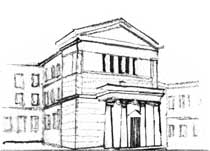Nuclear Physics Seminar
2006/2007 | 2007/2008 | 2008/2009 | 2009/2010 | 2010/2011 | 2011/2012 | 2012/2013 | 2013/2014 | 2014/2015 | 2015/2016 | 2016/2017 | 2017/2018 | 2018/2019 | 2019/2020 | 2020/2021 | 2021/2022 | 2022/2023 | 2023/2024 | 2024/2025
2010-06-02 (Wednesday)
prof. Tomasz Giebułtowicz (Oregon State University, Corvallis, USA)
Badania i kształcenie w dziedzinie energetyki i technologii jądrowej w Oregon State University
2010-05-26 (Wednesday)
dr Wojciech Gawlikowicz (ŚLCJ UW)
Dynamiczna emisja fragmentów w zderzeniach ciężkojonowych
2010-05-21 (Friday)
mgr Katarzyna Hadyńska-Klęk (ZFJA IFD i ŚLCJ UW)
Wzbudzenie kulombowskie pasma przypuszczalnie superzdeformowanego w 42Ca. Wstępne rezultaty pierwszego eksperymentu przeprowadzonego z wykorzystaniem spektrometru AGATA Demonstrator
Tematem wystąpienia będzie podsumowanie pionierskiego eksperymentu wzbudzenia kulombowskiego pasma przewidywalnie superzdeformowanego w 42Ca, przeprowadzonego na demonstratorze układu AGATA w lutym 2010 roku w Legnaro, jak również wstępne wyniki pierwszego etapu analizy danych.
2010-05-19 (Wednesday)
mgr Paweł Przewłocki (IPJ)
Badania tła do sygnału oscylacji neutrin poszukiwanego w eksperymencie T2K (Tokai2Kamioka)
2010-05-12 (Wednesday)
prof. Amnon Marinov (Jerusalem University, Izrael)
High spin super- and hyperdeformed isomeric states and long-lived superheavy elements
Back in 1971 a long-lived superheavy element with Z=112 has been produced via secondary reactions in CERN W targets which were irradiated with 24-GeV protons. For many years it was difficult to understand these results and in particular the long lifetime of several weeks of the new nucleus and its large deduced fusion cross section. In a parallel study, long-lived isomeric states have been found in various actinide nuclei produced in the same W target. It was then claimed that, as in the actinides, long-lived isomeric state has been produced in the superhavy element region. At that time the character of the isomeric states was not known. In more recent studies new kinds of isomeric states have been discovered by us. These are high spin isomers in the second (superdefomed) and third (hyper-deformed) minima of the potential energy surfaces, when plotted as a function of deformation. The existence of such isomeric states and their unusual radioactive decay properties enabled us to consistently interpret the production of the superheavy element with Z=112 and of some previously unexplained radioactivities seen in nature. Based on these results a search has been performed for the existence of long-lived isomeric states in natural materials using high resolution atomic mass measurements. Long-lived isomeric states with T1/2 ≥ 108 years have been found in the neutron-deficient 211,213,217,218Th nuclei, and in the superheavy element region, at atomic mass numbers 261 and 265, most probably at 261Rg and 265Rg (Z = 111), and at mass 292 and Z = 122, 292(Eka-Th).
2010-04-28 (Wednesday)
prof. dr hab. Jacek Dobaczewski (IFT UW i University of Jyväskylä, Finlandia)
Nowe idee w jądrowych zastosowaniach metody funkcjonału gęstości
2010-04-23 (Friday)
prof. dr hab. Marek Demiański (IFT UW)
Gwiazdy neutronowe z perspektywy Jabłonnej
W 1962 roku w Jabłonnie odbyła się międzynarodowa konferencja teorii grawitacji. Konferencja odbywała się w okresie narodzin nowej dziedziny badań - astrofizyki relatywistycznej. Chciałbym przypomnieć i opowiedzieć o znaczeniu tej konferencji a następnie zająć się historią badań nad własnościami gwiazd neutronowych i ich astrofizycznym znaczeniem.
2010-04-21 (Wednesday)
Prof. dr hab. Andrzej Góźdź (UMCS, Lublin)
Dyskretne symetrie wewnętrzne w jądrach atomowych
2010-04-14 (Wednesday)
prof. Marek Olechowski (IFT UW)
Ciemna materia - przegląd wyników doświadczalnych i modeli teoretycznych
2010-04-09 (Friday)
dr Nicholas Keeley (Zakład Reakcji Jądrowych IPJ - Hoża)
Following in Rutherford’s Footsteps: Reactions Induced by Exotic Helium Isotopes
Direct reaction and fusion data for 6He and 8He interacting with intermediate and heavy mass targets will be compared. We find that the extra two „valence” neutrons in 8He (compared to 6He) do not seem to play a significant role in the reactions of this most exotic nucleus.







